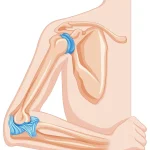When it comes to skin issues like itching, redness, or swelling, most of us think of harmless insect bites or allergic reactions. However, in rare cases, these symptoms can be indicative of something more serious – a subcutaneous parasitic infection. This occurs when parasites typically found in animals or specific environments make their way into human skin, causing a range of symptoms.
A fascinating case that caught medical attention worldwide was that of a Russian woman who discovered a shifting bump on her face in 2018. Initially thought to be a mosquito bite, the bump migrated from under her eye to her lip, leaving doctors puzzled. Further examination revealed a Dirofilaria repens worm, commonly found in dogs and transmitted through mosquito bites. Thankfully, the parasite was successfully removed through surgery, and the patient made a full recovery.
Subcutaneous parasitic infections can manifest in various ways, often causing discomfort and distress. Some common examples include ¹ ²:
Onchocerciasis (River Blindness): Transmitted through blackfly bites, this infection can lead to severe itching, skin nodules, and even vision impairment if left untreated.
Cutaneous Larva Migrans: Caused by hookworm larvae, this condition results in red, winding skin lines that can shift over time.
Loiasis (African Eye Worm): Transmitted via deerfly bites, this infection can cause intermittent skin swellings and even visible movement under the skin or across the eye.
Swimmer’s Itch: A temporary skin condition caused by schistosome larvae in freshwater lakes and ponds, characterized by red, itchy bumps.
Guinea Worm Disease: Although rare today, this waterborne parasite once caused intense skin symptoms when adult worms emerged through painful blisters.
To identify potential parasitic infections, look out for warning signs such as:
Persistent itching or irritation: If the itching doesn’t subside with typical treatments.
Moving bumps or nodules: Skin lesions that change location or shape over time.
Red lines or swelling: Unusual skin patterns or reactions without an apparent cause.
Recent travel or exposure: Symptoms that appear after visiting areas with known parasitic risks or exposure to untreated water or soil.
If you suspect a parasitic infection, seeking medical attention is crucial. Doctors may use various diagnostic tools, including physical exams, imaging tests like ultrasound or MRI, blood tests, or biopsies, to determine the cause of your symptoms.
Preventing parasitic infections is often straightforward ¹ ³:
Use insect repellents: Apply EPA-approved repellents when in areas with biting insects.
Avoid contaminated water and soil: Steer clear of freshwater lakes or rivers in regions where waterborne infections are prevalent.
Wear protective clothing: Cover up with long-sleeved shirts and pants in areas with biting insects.
Practice good hygiene: Consume safe, filtered, or boiled water when traveling to regions with limited sanitation.
By being aware of the risks and taking preventive measures, you can minimize the chances of contracting a subcutaneous parasitic infection. If you notice unusual skin symptoms, don’t hesitate to seek medical attention. Prompt treatment can ensure effective care and prevent complications.


